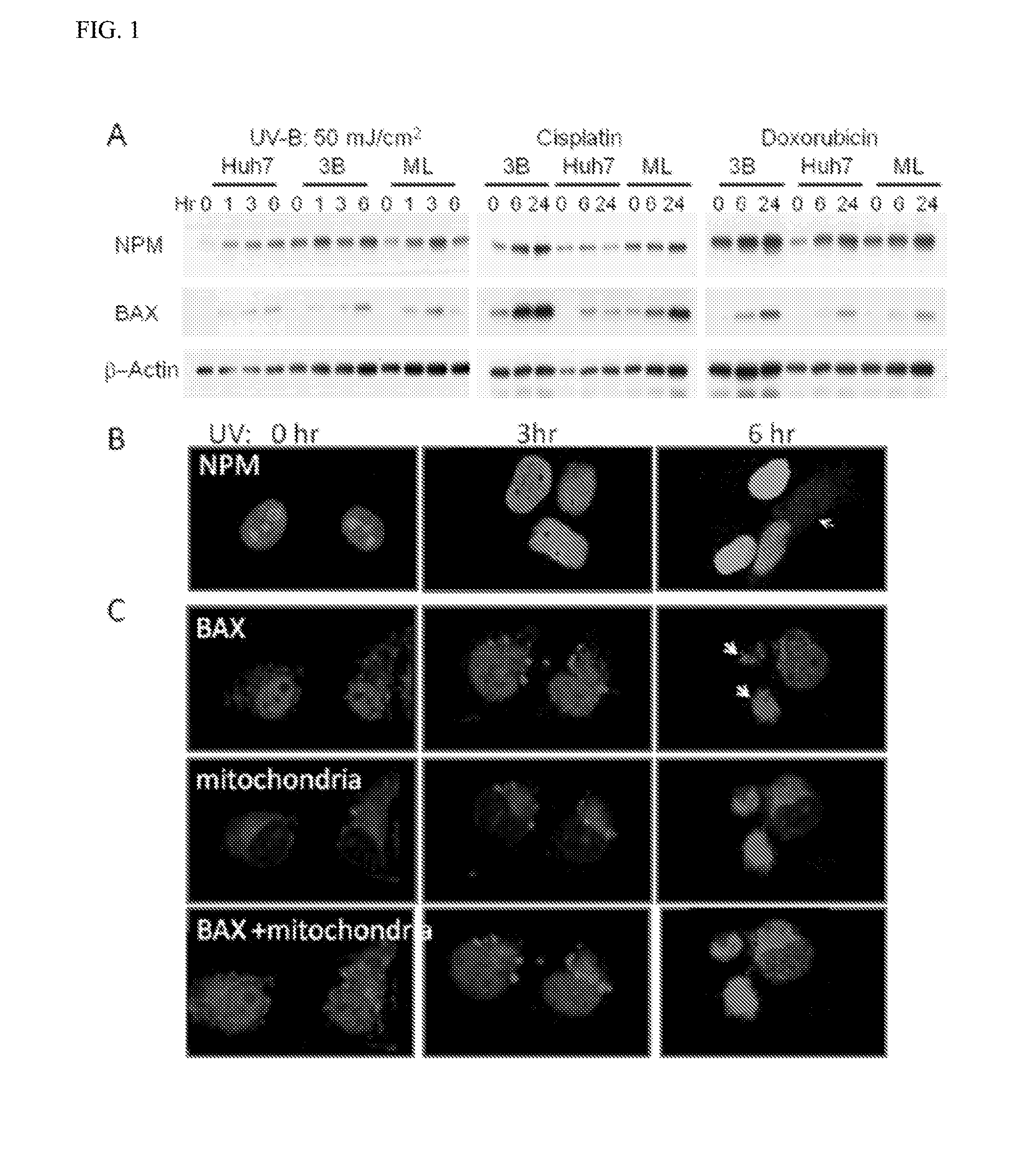Novel pharmaceutical composition and uses thereof
a technology of composition and use, applied in the field of new pharmaceutical composition and use thereof, can solve the problems of major public health problems worldwide, and the medical community is still faced with the challenge, and achieve the effects of reducing or inhibiting cancer growth, and adding or synergistic effects on cancer inhibition
- Summary
- Abstract
- Description
- Claims
- Application Information
AI Technical Summary
Benefits of technology
Problems solved by technology
Method used
Image
Examples
example 1
In-Vitro Evaluation of NPM Inhibitor and Anti-Cancer Agents Combination in HCC
[0073]HCC cell lines with different p53 backgrounds, including HepG2 (wild-type p53), Huh7 (C200Y mutated p53), Mahlavu (R249S mutant p53), and Hep3B (deleted p53) were used in this study.
[0074]Referring to FIG. 3, the doses for UVB, MMC, DOXO and CODP at 0 mJ / cm2 or mg / ml indicate HCC cells were not treated with UV-B or conventional chemotherapeutic agents. The siNPM (siRNA inhibiting NPM expression) bars represents groups without UV-B or chemotherapeutic agent treatment but with NPM suppression. The siNS bars represent groups without UV-B, chemotherapeutic agent treatment or NPM suppression. Inhibition of NPM expression by siNPM was confirmed by immunoblotting (FIG. 3, right lower panel).
[0075]HCC cells were treated with UV-B or one of the conventional chemotherapeutic agents when the doses for UVB, MMC, DOXO and CODP are above 0 mJ / cm2 or ug / ml. In this group, the siNs bars represent groups without NPM ...
example 2
Induction of NPM and BAX Expression by Cellular Stresses
[0081]Now referring to FIG. 1A, NPM was upregulated in Huh7, Hep3B, and Mahlavu cells following UV-B (50 mJ / cm2), cisplatin [5.5, 69, and 6.4 μg / ml for Hep3B (3B), HepG2 (G2) and Mahlavu (ML), respectively], and doxorubicin [1.4, 8.8, and 5 μg / ml for Hep3B, HepG2 and Mahlavu, respectively] exposure. BAX expression was also increased in all three HCC cell lines following the treatment of UV-B, cisplatin, and doxorubicin. The expression of β-actin was used as the loading control. Simultaneous induction of BAX (pro-apoptosis) and NPM (anti-apoptosis) of cells upon cellular stress represents counteracting mechanisms regulating apoptosis versus survival response.
example 3
Nucleoplasmic and Cytoplasmic Translocation of NPM Following Cellular Stresses
[0082]Prior to UV irradiation, NPM was mainly located in the nucleoli and a small amount was present in nucleoplasm (FIG. 1B, left panel), while BAX was primarily located in nucleoplasm and a small amount was located in the cytoplasm (FIG. 1C, left panel). Following UV irradiation, NPM was translocated from nucleoli to nucleoplasm (FIG. 1B, middle), and cytoplasm (FIG. 1B, right panel, indicated by an arrow). On the other hand, BAX was translocated to cytosol and accumulated in the mitochondria, particularly in cells undergo apoptosis (FIG. 1C, right panel; indicated by arrows).
[0083]Following the suppression of NPM expression by siRNA, HCC cells with relatively low NPM expression have more BAX aggregated in the mitochondria and were found to be more prone to apoptosis, whereas cells with relatively high NPM level have less mitochondrial BAX accumulation and were found to be more resistance to apoptosis. T...
PUM
| Property | Measurement | Unit |
|---|---|---|
| Chemotherapeutic properties | aaaaa | aaaaa |
Abstract
Description
Claims
Application Information
 Login to view more
Login to view more - R&D Engineer
- R&D Manager
- IP Professional
- Industry Leading Data Capabilities
- Powerful AI technology
- Patent DNA Extraction
Browse by: Latest US Patents, China's latest patents, Technical Efficacy Thesaurus, Application Domain, Technology Topic.
© 2024 PatSnap. All rights reserved.Legal|Privacy policy|Modern Slavery Act Transparency Statement|Sitemap



